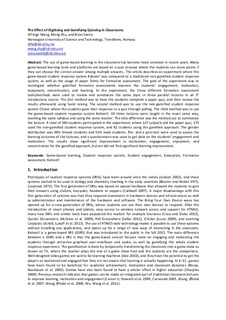| dc.contributor.author | Wang, Alf Inge | |
| dc.contributor.author | Zhu, Meng | |
| dc.contributor.author | Sætre, Rune | |
| dc.date.accessioned | 2016-11-07T10:51:14Z | |
| dc.date.accessioned | 2017-01-05T09:50:36Z | |
| dc.date.available | 2016-11-07T10:51:14Z | |
| dc.date.available | 2017-01-05T09:50:36Z | |
| dc.date.issued | 2016 | |
| dc.identifier.citation | Connolly, Thomas; Liz, Boyle [Eds.] Proceedings of The 10th European Conference on Games Based Learning p. 729-737 Proceedings of the ... European conference on games-based learning, Academic Conferences and Publishing International Limited, 2016 | nb_NO |
| dc.identifier.isbn | 978‐1‐911218‐09‐8 | |
| dc.identifier.issn | 2049-0992 | |
| dc.identifier.uri | http://hdl.handle.net/11250/2426374 | |
| dc.description.abstract | The use of game-based learning in the classroom has become more common in recent years. Many game-based learning tools and platforms are based on a quiz concept where the students can score points if they can choose the correct answer among multiple answers. The article describes an experiment where the game-based student response system Kahoot! was compared to a traditional non-gamified student response system, as well as the usage of paper forms for formative assessment. The goal of the experiment was to investigate whether gamified formative assessments improve
the students’ engagement, motivation, enjoyment, concentration, and learning. In the experiment, the three different formative assessment tools/methods were used to review and summarize the same topic in three parallel lectures in an IT introductory course. The first method was to have the students complete a paper quiz, and then review the results afterwards using hand raising. The second method was to use the non-gamified student response system Clicker where the students gave their response to a quiz through polling. The third method was to use the game-based student response system Kahoot!. All three lectures were taught in the exact same way, teaching the same syllabus and using the same teacher. The only differences were the lecture hall and the method use to summarize the lecture. A total of 384 students participated in the experiment, where 127 subjects did the paper quiz, 175 used the non-gamified student response
system, and 82 students using the gamified approach. The gender distribution was 48% female students and 52% male
students. Pre- and a post-test were used to assess the learning outcome of the lectures, and a questionnaire was used to get data on the students’ engagement and motivation. The results show significant improvement in motivating, engagement, enjoyment, and concentration for the gamified approach, but we did not find significant learning improvement. | nb_NO |
| dc.language.iso | eng | nb_NO |
| dc.publisher | Academic Conferences and Publishing International | nb_NO |
| dc.relation.uri | http://www.idi.ntnu.no/~alfw/publications/ECGBL2016-Effect_of_digitizing_and_gamifying_quizzing.pdf | |
| dc.title | The Effect of Digitizing and Gamifying Quizzing in Classrooms | nb_NO |
| dc.type | Chapter | nb_NO |
| dc.date.updated | 2016-11-07T10:51:14Z | |
| dc.description.version | acceptedVersion | |
| dc.subject.nsi | VDP::Matematikk og naturvitenskap: 400::Informasjons- og kommunikasjonsvitenskap: 420::Systemutvikling og -arbeid: 426 | nb_NO |
| dc.subject.nsi | VDP::Mathematics and natural scienses: 400::Information and communication science: 420::System development and design: 426 | nb_NO |
| dc.identifier.cristin | 1396686 | |
| dc.subject.keyword | Spillbasert læring / Game based learning | |
